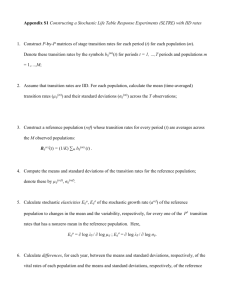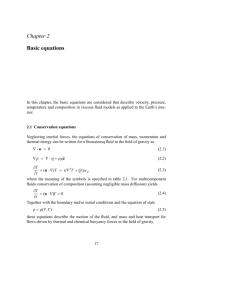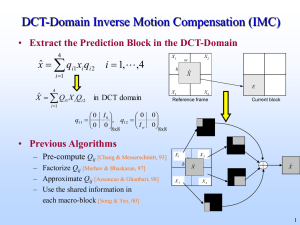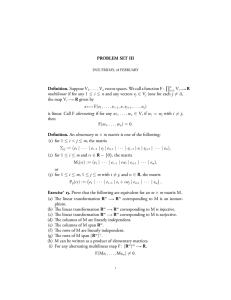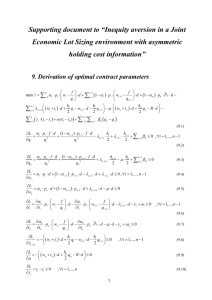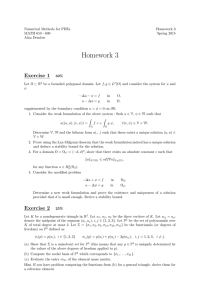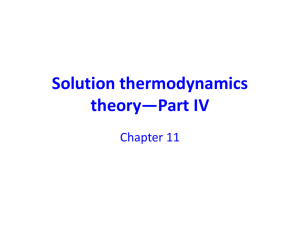Electronic Journal of Differential Equations, Vol. 2006(2006), No. 32, pp.... ISSN: 1072-6691. URL: or
advertisement
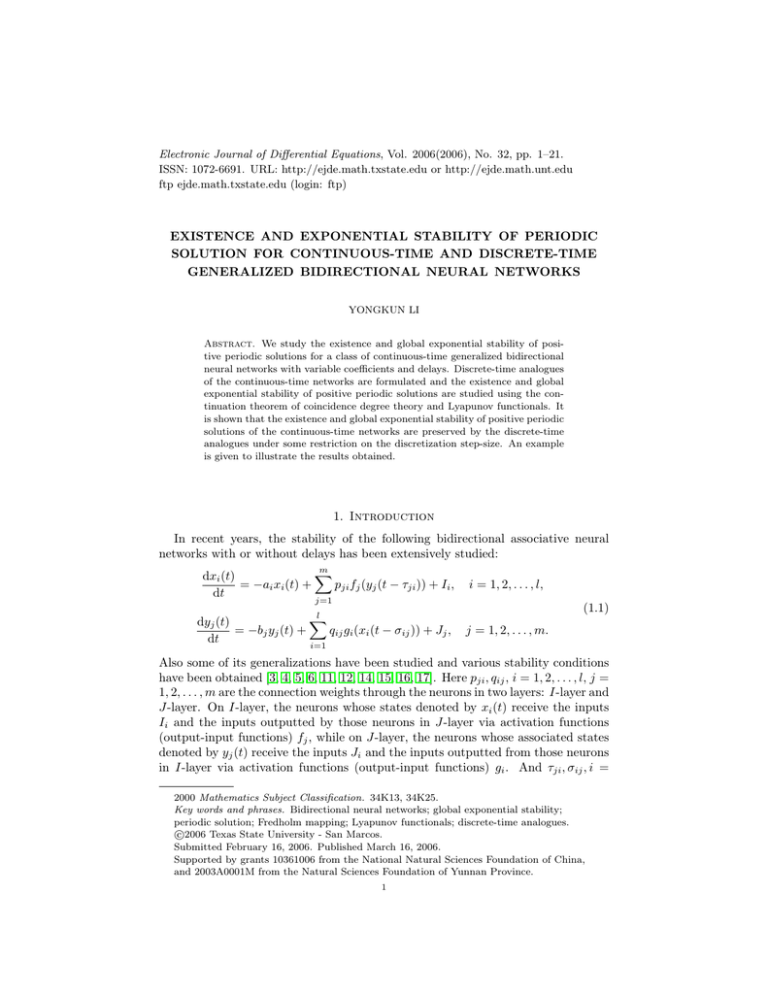
Electronic Journal of Differential Equations, Vol. 2006(2006), No. 32, pp. 1–21.
ISSN: 1072-6691. URL: http://ejde.math.txstate.edu or http://ejde.math.unt.edu
ftp ejde.math.txstate.edu (login: ftp)
EXISTENCE AND EXPONENTIAL STABILITY OF PERIODIC
SOLUTION FOR CONTINUOUS-TIME AND DISCRETE-TIME
GENERALIZED BIDIRECTIONAL NEURAL NETWORKS
YONGKUN LI
Abstract. We study the existence and global exponential stability of positive periodic solutions for a class of continuous-time generalized bidirectional
neural networks with variable coefficients and delays. Discrete-time analogues
of the continuous-time networks are formulated and the existence and global
exponential stability of positive periodic solutions are studied using the continuation theorem of coincidence degree theory and Lyapunov functionals. It
is shown that the existence and global exponential stability of positive periodic
solutions of the continuous-time networks are preserved by the discrete-time
analogues under some restriction on the discretization step-size. An example
is given to illustrate the results obtained.
1. Introduction
In recent years, the stability of the following bidirectional associative neural
networks with or without delays has been extensively studied:
m
X
dxi (t)
= −ai xi (t) +
pji fj (yj (t − τji )) + Ii ,
dt
j=1
l
X
dyj (t)
qij gi (xi (t − σij )) + Jj ,
= −bj yj (t) +
dt
i=1
i = 1, 2, . . . , l,
(1.1)
j = 1, 2, . . . , m.
Also some of its generalizations have been studied and various stability conditions
have been obtained [3, 4, 5, 6, 11, 12, 14, 15, 16, 17]. Here pji , qij , i = 1, 2, . . . , l, j =
1, 2, . . . , m are the connection weights through the neurons in two layers: I-layer and
J-layer. On I-layer, the neurons whose states denoted by xi (t) receive the inputs
Ii and the inputs outputted by those neurons in J-layer via activation functions
(output-input functions) fj , while on J-layer, the neurons whose associated states
denoted by yj (t) receive the inputs Ji and the inputs outputted from those neurons
in I-layer via activation functions (output-input functions) gi . And τji , σij , i =
2000 Mathematics Subject Classification. 34K13, 34K25.
Key words and phrases. Bidirectional neural networks; global exponential stability;
periodic solution; Fredholm mapping; Lyapunov functionals; discrete-time analogues.
c
2006
Texas State University - San Marcos.
Submitted February 16, 2006. Published March 16, 2006.
Supported by grants 10361006 from the National Natural Sciences Foundation of China,
and 2003A0001M from the Natural Sciences Foundation of Yunnan Province.
1
2
Y. LI
EJDE-2006/32
1, 2, . . . , l, j = 1, 2, . . . , m are the associated delays due to the finite transmission
speed among neurons in different layers.
When there is no delay present, (1.1) reduces to a system of ordinary differential
equations which was investigated by Kosko [7, 8, 9] and it produces many nice
properties due to the special structure of connection weights and has practical
applications in storing paired patterns or memories and the ability to search the
desired patterns via both directions: forward and backward directions. See [3, 14,
7, 8, 9] for details about the applications on learning and associative memories.
It is well known that in the study of neural dynamical systems, the periodic
oscillatory behavior of the systems is an important aspect. In this paper, we are
concerned with the following generalized BAM networks with variable coefficients
and delays
m
m
X
X
dxi (t)
= −ai (t)xi (t) +
aji (t)fj (yj (t)) +
pji (t)gj (yj (t − τji (t))) + Ii (t),
dt
j=1
j=1
l
l
X
X
dyj (t)
= −bj (t)yj (t) +
bij (t)fˆi (xi (t)) +
qij (t)ĝi (xi (t − σij (t))) + Jj (t),
dt
i=1
i=1
(1.2)
for i = 1, 2, . . . , l, j = 1, 2, . . . , m.
In this paper, we assume that
(S1) ai , bj ∈ C(R, (0, ∞)), τji , σij ∈ C(R, [0, ∞)), Ii , Jj , pji , qij ∈ C(R, R), i =
1, 2, . . . , l, j = 1, 2, . . . , m are all ω-periodic functions.
(S2) fj , gj , fˆi , ĝi ∈ C(R, R) i = 1, 2, . . . , l, j = 1, 2, . . . , m are bounded on R.
ˆ
(S3) There exist positive number Lfj , Lgj , Lfi , Lĝj such that
|fj (x) − fj (y)| ≤ Lfj |x − y| for all x, y ∈ R, j = 1, 2, . . . , m,
|gj (x) − gj (y)| ≤ Lgj |x − y| for all x, y ∈ R, j = 1, 2, . . . , m,
ˆ
|fˆi (x) − fˆi (y)| ≤ Lfi |x − y| for all x, y ∈ R, i = 1, 2, . . . , l,
|ĝi (x) − ĝi (y)| ≤ Lĝi |x − y| for all x, y ∈ R, i = 1, 2, . . . , l.
Our purpose of this paper is by using Mawhin’s continuation theorem of coincidence degree theory [2, 13] and by constructing suitable Lyapunov functions
to investigate the stability and existence of periodic solutions of (1.2); then, we
shall use a novel method in formulating discrete-time analogues of the continuous
time networks. It is shown that the existence and global exponential stability of
positive periodic solutions of the continuous-time networks are preserved by the
discrete-time analogues under some restriction on the discretization step-size.
2. Existence of periodic solutions
In this section, based on the Mawhin’s continuation theorem, we shall study the
existence of at least one positive periodic solution of (1.2). First, we shall make
some preparations.
Let X, Y be normed vector spaces, L : Dom L ⊂ X → Y be a linear mapping, and
N : X → Y be a continuous mapping. The mapping L will be called a Fredholm
mapping of index zero if dim ker L = codim Im L < +∞ and Im L is closed in Y. If
L is a Fredholm mapping of index zero, there exist continuous projectors P : X → X
EJDE-2006/32
EXISTENCE AND EXPONENTIAL STABILITY
3
and Q : Y → Y such that Im P = ker L, ker Q = Im L = Im(I − Q). It follows that
mapping L|Dom L T ker P : (I − P )X → Im L is invertible. We denote the inverse of
that mapping by KP . If Ω is an open bounded subset of X, the mapping N will be
called L- compact on Ω̄ if QN (Ω̄) is bounded and KP (I − Q)N : Ω̄ → X is compact.
Since Im Q is isomorphic to ker L, there exists an isomorphism J : Im Q → ker L.
For convenience of use, we introduce Mawhin’s continuation theorem [2, P. 40]
as follows.
Lemma 2.1. Let Ω ⊂ X be an open bounded set and let N : X → Y be a continuous
operator which is L-compact on Ω̄ (i.e., QN : Ω̄ → Y and KP (I − Q)N : Ω̄ → Y
are compact). Assume
T
(a) for each λ ∈ (0, 1),
T x ∈ ∂Ω Dom LLx 6= λN x,
(b) for each x ∈ T
∂Ω ker L. QN x 6= 0,
(c) deg(JN Q, Ω ker L, 0) 6= 0.
T
Then Lx = N x has at least one solution in Ω̄ Dom L.
Our result about the existence of periodic solutions of (1.2) is as follows.
Theorem 2.2. Assume that (S1) and (S2) hold. Then system (1.2) has at least
one ω-periodic solution.
Proof. To use the continuation theorem of coincidence degree theory to establish
the existence of an ω-periodic solution of (1.2), we take X = Y = {u ∈ C(R, Rl+m ) :
Pl+m
u(t + ω) = u(t)} and kuk = i=1 maxt∈[0,ω] |ui (t)|, then X is a Banach space. Set
L : Dom L ∩ X,
Lu = u̇(t),
u ∈ X,
where Dom L = {u ∈ C 1 (R, Rl+m )} and N : X → X, N [x1 , . . . , xl , y1 , . . . , ym ]T =
Pm
aj1 (t)fj (yj (t)) + j=1 pj1 (t)gj (yj (t − τj1 (t))) + I1 (t)
..
.
−a (t)x (t) + Pm a (t)f (y (t)) + Pm p (t)g (y (t − τ (t))) + I (t)
l
l
j j
j j
jl
l
j=1 jl
j=1 jl
P
P
.
−b1 (t)y1 (t) + li=1 bi1 (t)fˆi (xi (t)) + li=1 qi1 (t)ĝi (xi (t − σi1 (t))) + J1 (t)
..
.
Pl
P
l
bim (t)fˆi (xi (t)) +
qim (t)ĝi (xi (t − σim (t))) + Jm (t)
−bm (t)ym (t) +
−a1 (t)x1 (t) +
Pm
j=1
i=1
i=1
Define two projectors P and Q as
1
P u = Qu =
ω
Z
ω
u(t) dt, u ∈ X.
0
Rω
Clearly, ker L = Rl+m , Im L = {(x1 , x2 , . . . , xl , y1 , . . . , ym )T ∈ X : 0 xi (t) dt =
Rω
0, 0 yj (t) dt = 0, i = 1, 2, . . . , l, j = 1, 2, . . . , m} is closed in X and dim ker L =
codim Im L = l + m. Hence, L is a Fredholm mapping of index zero. Furthermore,
similar to the proof of [10, Theorem 1], one can easily show that N is L-compact
on Ω̄ with any open bounded set Ω ⊂ X. Corresponding to operator equation
4
Y. LI
EJDE-2006/32
Lu = λN u, λ ∈ (0, 1), we have
m
m
h
i
X
X
dxi (t)
= λ − ai (t)xi (t) +
aji (t)fj (yj (t)) +
pji (t)gj (yj (t − τji (t))) + Ii (t) ,
dt
j=1
j=1
l
l
h
i
X
X
dyj (t)
= λ − bj (t)yj (t) +
bij (t)fˆi (xi (t)) +
qij (t)ĝi (xi (t − σij (t))) + Jj (t)
dt
i=1
i=1
(2.1)
for i = 1, 2, . . . , l, j = 1, 2, . . . , m. Suppose that (x1 , x2 , . . . , xl , y1 , y2 , . . . , ym ) ∈ X
is a solution of (2.1) for some λ ∈ (0, 1). Let ξ¯i , ζ̄j ∈ [0, ω] such that xi (ξ¯i ) =
maxt∈[0,ω] xi (t) and yj (ζ̄j ) = maxt∈[0,ω] yj (t), i = 1, 2, . . . , l, j = 1, 2 . . . , m, then
m
X
ai (ξ¯i )xi (ξ¯i ) =
aji (ξ¯i )fj (yj (ξ¯i )) +
j=1
m
X
pji (ξ¯i )gj (yj (ξ¯i − τji (ξ¯i ))) + Ii (ξ¯i )
j=1
and
l
X
bj (ζ̄j )yj (ζ̄j ) =
l
X
bij (ζ̄j )fˆi (xi (ζ̄j )) +
i=1
qij (ζ̄j )ĝi (xi (ζ̄j − σij (ζ̄j ))) + Jj (ζ̄j ),
i=1
for i = 1, 2, . . . , l, j = 1, 2, . . . , m. Hence,
ai (ξ¯i )xi (ξ¯i ) ≤
m
X
m
X
|aji (ξ¯i )||fj (yj (ξ¯i ))| +
j=1
bj (ζ̄j )yj (ζ̄j ) ≤
l
X
|pji (ξ¯i )||gj (yj (ξ¯i − τji (ξ¯i )))| + |Ii (ξ¯i )|,
j=1
|bij (ζ̄j )||fˆi (xi (ζ̄j ))| +
l
X
i=1
|qij (ζ̄j )||ĝi (xi (ζ̄j − σij (ζ̄j )))| + |Jj (ζ̄j )|
i=1
for i = 1, 2, . . . , l, j = 1, 2, . . . , m. Therefore,
1
xi (ξ¯i ) ≤ [mMf aM + mMg pM + I M ], i = 1, 2, . . . , l,
a
1
yj (ζ̄j ) ≤ [lMfˆbM + lMĝ q M + J M ], j = 1, 2, . . . , m,
b
where
a = min {ai (t), i = 1, 2, . . . , n},
t∈[0,ω]
Mf = sup {|fj (u)|, j = 1, 2, . . . , m},
u∈R
b = min {bj (t), i = 1, 2, . . . , l},
t∈[0,ω]
Mg = sup {|gj (u)|, j = 1, 2, . . . , m},
u∈R
Mfˆ = sup {|fˆi (u)|, i = 1, 2, . . . , l},
u∈R
M
a
Mĝ = sup {|ĝi (u)|, i = 1, 2, . . . , l},
u∈R
= max {|aji (t)|, i = 1, 2, . . . , l, j = 1, 2, . . . , m},
t∈[0,ω]
b
M
= max {|bij (t)|,
i = 1, 2, . . . , l, j = 1, 2, . . . , m},
t∈[0,ω]
pM = max {|pji (t)|, i = 1, 2, . . . , l, j = 1, 2, . . . , m},
t∈[0,ω]
q
M
= max {|qij (t)|, i = 1, 2, . . . , l, j = 1, 2, . . . , m},
t∈[0,ω]
I
M
= max {|Ii (t)|, i = 1, 2, . . . , l},
t∈[0,ω]
J M = max {|Ji (t)|, j = 1, 2, . . . , m}.
t∈[0,ω]
EJDE-2006/32
EXISTENCE AND EXPONENTIAL STABILITY
5
Let ξ i , ζ j ∈ [0, ω] be such that xi (ξ i ) = mint∈[0,ω] xi (t) and yj (ζ j ) = mint∈[0,ω] yj (t),
i = 1, 2, . . . , l, j = 1, 2, . . . , m, then
m
X
ai (ξ i )xi (ξ i ) =
aji (ξ i )fj (yj (ξ i )) +
j=1
n
X
j=1
n
X
i=1
i=1
bij (ζ j )fˆi (xi (ζ j )) +
bj (ζ j )yj (ζ j ) =
m
X
pji (ξ i )gj (yj (ξ i − τji (ξ i ))) + Ii (ξ i )
qij (ζ j )ĝi (xi (ζ j − σij (ζ j ))) + Jj (ζ j )
for i = 1, 2, . . . , l, j = 1, 2, . . . , m. Thus,
ai (ξ i )xi (ξ i )
≥−
m
X
m
X
|aji (ξ i )||fj (yj (ξ i ))| −
j=1
|pji (ξ i )||gj (yj (ξ i − τji (ξ i )))| − |Ii (ξ i )|,
j=1
bj (ζ j )yj (ζ j )
≥−
n
X
|bij (ζ j )||fˆi (xi (ζ j ))| −
i=1
n
X
|qij (ζ j )||ĝi (xi (ζ j − σij (ζ j )))| − |Jj (ζ j )|
i=1
for i = 1, 2, . . . , l, j = 1, 2, . . . , m. Therefore,
1
xi (ξ¯i ) ≥ − [mMf aM + mMg pM + I M ],
a
1
yj (ζ̄j ) ≥ − [lMfˆbM + lMĝ q M + J M ]
b
for i = 1, 2, . . . , l, j = 1, 2, . . . , m. Denote C = al [mMf aM + mMg pM + I M ] +
m
M
+ lMĝ q M + J M ] + D, where D is a positive constant. Then it is clear
b [lMfˆb
that C is independent of λ. Now we take Ω T
= {u ∈ X : kuk
T < C}. This Ω satisfies
condition (a) in Lemma 2.1. When u ∈ ∂Ω ker L = ∂Ω Rl+m , u is a constant
vector in Rm+n with kuk = C. Then
uT QN u =
l n
X
− āi x2i +
i=1
+
m
X
āji xi fj (yj ) +
j=1
m n
X
− b̄j yj2 +
j=1
l
X
m
X
p̄ji xi gj (yj ) + xi I¯i
o
j=1
b̄ij yj fˆi (xi ) +
i=1
l
X
q̄ij yj ĝi (xi ) + yj J¯j
o
< 0,
i=1
where u = (x1 , x2 , . . . , xl , y1 , y2 , . . . , ym ). If necessary, we can let C be large such
that
l n
X
− āi x2i +
i=1
+
m n
X
āji xi fj (yj ) +
j=1
− b̄j yj2 +
j=1
So for any u ∈ ∂Ω
is satisfied.
m
X
l
X
i=1
T
m
X
p̄ji xi gj (yj ) + xi I¯i
o
j=1
b̄ij yj fˆi (xi ) +
l
X
q̄ij yj ĝi (xi ) + yj J¯j
o
< 0.
i=1
ker L, QN u 6= 0. This proves that condition (b) in Lemma 2.1
6
Y. LI
EJDE-2006/32
Furthermore, let Ψ(γ; u) = −γu + (1 − γ)QN u, then for any x ∈ ∂Ω ∩ ker L,
uT Ψ(γ; u) < 0, we get
deg{JQN, Ω ∩ ker L, 0} = deg{−u, Ω ∩ ker L, 0} =
6 0,
hence condition (c) of Lemma 2.1 is also satisfied. Thus, by Lemma 2.1 we conclude
that Lu = N u has at least one solution in X, that is, (1.2) has at least one ω-periodic
solution. The proof is complete.
Next, we shall construct some suitable Lyapunov functionals to derive the sufficient conditions which ensure that the global exponential stability of periodic
solutions of the system (1.2) associated with the initial conditions
xi (s) = ϕi (s),
s ∈ [−τ, 0],
yj (s) = ψj (s),
s ∈ [−σ, 0],
τ = max {τji (t), i = 1, 2, . . . , l, j = 1, 2, . . . , m},
t∈[0,ω]
σ = max {σij (t), i = 1, 2, . . . , l, j = 1, 2, . . . , m},
t∈[0,ω]
where ϕi ∈ C([−τ, 0], R), ψi ∈ C([−σ, 0], R), i = 1, 2, . . . , l, j = 1, 2, . . . , m. In the
sequel, we will use the following notation:
am
i = min ai (t),
bm
j = min bj (t),
t∈[0,ω]
bM
ij = max |qij (t)|,
t∈[0,ω]
M
τji
= max |τji (t)|,
t∈[0,ω]
pM
ji
aM
ji = max |pji (t)|,
t∈[0,ω]
t∈[0,ω]
= max |pji (t)|,
t∈[0,ω]
M
qij
M
σij
= max |σij (t)|,
t∈[0,ω]
= max |qij (t)|,
t∈[0,ω]
where i = 1, 2, . . . , l, j = 1, 2, . . . , m.
Our result about the global exponential stability of periodic solutions of (1.2) is
as follows.
Theorem 2.3. Assume that (S1)-(S3) hold. Furthermore, assume
(P1) For i = 1, 2, . . . , l and j = 1, 2, . . . , m, σij , τji ∈ C 1 (R, [0, ∞)) satisfy
0M
0
σij
= max σij
(t) < 1,
t∈[0,ω]
0M
0
τji
= max τji
(t) < 1,
t∈[0,ω]
(P2)
am
i >
m X
ˆ
f
bM
ij Li +
j=1
bm
j >
l X
f
aM
ji Lj +
i=1
M ĝ qij
Li
,
0M
1 − σij
g pM
ji Lj
0M
1 − τji
,
i = 1, 2, . . . , l,
j = 1, 2, . . . , m,
∗ T
then (1.2) has a unique ω-periodic solution (x∗1 , x∗2 , . . . , x∗l , y1∗ , y2∗ , . . . , ym
) and,
moreover, there exist constants η > 0 and Λ ≥ 1 such that for t > 0,
l
X
|xi (t) − x∗i (t)| +
i=1
≤ Λe−ηt
m
X
|yj (t) − yj∗ (t)|
j=1
l
hX
sup |xi (s) − x∗i (s)| +
i=1 s∈[−τ,0]
m
X
i
sup |yj (s) − yj∗ (s)| .
j=1 s∈[−σ,0]
EJDE-2006/32
EXISTENCE AND EXPONENTIAL STABILITY
7
Proof. Let x(t) = {x1 (t), x2 (t), . . . , xl (t), y1 (t), y2 (t), . . . , ym (t)} be an arbitrary so∗
lution of (1.2), and x∗ (t) = {x∗1 (t), x∗2 (t), . . . , x∗l (t), y1∗ (t), y2∗ (t), . . . , ym
(t)} be an
ω-periodic solution of (1.2). Then
m
X
d+ (xi (t) − x∗i (t))
f
∗
∗
≤ −am
|x
(t)
−
x
(t)|
+
aM
i
i
i
ji Lj |yj (t) − yj (t)|
dt
j=1
+
m
X
g
∗
pM
ji Lj |yj (t − τji (t)) − yj (t − τji (t))|,
j=1
n
X
d+ (yj (t) − yj∗ (t))
fˆ
∗
∗
≤ −bm
|y
(t)
−
y
(t)|
+
bM
j
j
j
ij Li |xi (t) − xi (t)|
dt
i=1
+
n
X
(2.2)
M ĝ
qij
Li |xi (t − σij (t)) − x∗i (t − σij (t))|,
i=1
fori = 1, 2, . . . , l, j = 1, 2, . . . , m. Let Fi and Gj be defined by
Fi (εi ) =
am
i
m X
− εi −
fˆ
bM
ij Li +
j=1
Gj (ζj ) =
bm
j
− ζj −
l X
f
aM
ji Lj
+
i=1
M
M ĝ εi σij
qij
Li e
,
0M
1 − σij
M
g ζj τji
pM
ji Lj e
0M
1 − τji
i = 1, 2, . . . , l,
,
j = 1, 2, . . . , m,
where εi , ζj ∈ [0, ∞). It is clear that
Fi (0) = am
i −
m X
M ĝ qij
Li
> 0,
0M
1 − σij
ˆ
f
bM
ij Li +
j=1
Gj (0) = bm
j −
l X
f
aM
ji Lj +
i=1
g pM
ji Lj
0M
1 − τji
> 0,
i = 1, 2, . . . , l,
j = 1, 2, . . . , m.
Since Fi (·) and Gj (·) are continuous on [0, ∞) and Fi (εi ), Gj (ζj ) → ∞ as εi , ζj →
∞, there exist ε∗i , ζj∗ > 0 such that Fi (εi ) = 0, Gj (ζj ) = 0 for εi ∈ (0, ε∗i ) and
Fi (εi ) > 0, Gj (ζj ) > 0 for ζj ∈ (0, ζj∗ ). By choosing
∗
η = min{ε∗1 , ε∗2 , . . . , ε∗l , ζ1∗ , ζ2∗ , . . . , ζm
},
we obtain
Fi (η) =
am
i
−η−
m X
fˆ
bM
ij Li +
j=1
Gi (η) =
bm
j
−η−
l X
f
aM
ji Lj
+
i=1
M
M ĝ ησij
qij
Li e
≥ 0,
0M
1 − σij
M
g ητji
pM
ji Lj e
0M
1 − τji
≥ 0,
i = 1, 2, . . . , l,
j = 1, 2, . . . , m.
Now let us define
ui (t) = eηt |xi (t) − x∗i (t)|,
ηt
vj (t) = e |yj (t) −
yj∗ (t)|,
t ∈ [−τ, ∞), i = 1, 2, . . . , l,
t ∈ [−τ, ∞), j = 1, 2, . . . , m.
(2.3)
8
Y. LI
EJDE-2006/32
Then it follows from (2.2) and (2.3) that
m
m
X
X
d+ ui (t)
g ητji (t)
m
M f
≤ −(ai − η)ui (t) +
aji Lj vj (t) +
pM
vj (t − τji (t)),
ji Lj e
dt
j=1
j=1
n
n
X
X
d+ vj (t)
M fˆ
M ĝ ησij (t)
≤ −(bm
−
η)v
(t)
+
b
L
u
(t)
+
qij
Li e
ui (t − σij (t)),
j
j
ij i i
dt
i=1
i=1
(2.4)
i = 1, 2, . . . , n, j = 1, 2, . . . , m. Consider a Lyapunov function defined by
V (t) =
l X
ui (t) +
i=1
+
M Z
g ητji
m
X
pM
ji Lj e
j=1
m X
1−
0M
τji
vj (t) +
vj (s) ds
t−τji (t)
M
M ĝ ησij
qij
Li e
0M
1 − σij
i=1
l
X
j=1
t
(2.5)
Z
t
ui (s) ds ,
t−σij (t)
and we note that V (t) > 0 for t > 0 and V (0) is positive and finite. Calculating
the derivatives of V along the solutions of (2.4), we get
M
g ητji
l h
m
m
i
X
X
X
pM
dV +
ji Lj e
m
M f
v
(t)
≤
− (ai − η)ui (t) +
aji Lj vj (t) +
j
0M
dt
1 − τji
i=1
j=1
j=1
+
m h
X
−
(bm
j
− η)vj (t) +
j=1
≤−
l h
X
am
i
m
X
−η−
fˆ
bM
ij Li −
j=1
m h
X
bm
j
−η−
j=1
=−
l
M ĝ ησij
X
qij
Li e
+
l
X
Fi (η)ui (t) −
i=1
i=1
M
m
M ĝ ησij
X
qij
Li e
j=1
f
aM
ji Lj
−
i=1
l
X
M
fˆ
bM
ij Li ui (t)
i=1
i=1
−
l
X
M
g ητji
l
X
pM
ji Lj e
i=1
m
X
0M
1 − σij
0M
1 − τji
Gj (η)vj (t) ≤ 0,
0M
1 − σij
i
ui (t)
i
ui (t)
i
vj (t)
t > 0.
j=1
It follows that V (t) ≤ V (0) for t > 0 and hence from (2.3) and (2.5) we obtain
l
X
i=1
ui (t) +
m
X
j=1
vj (t) ≤
l X
ui (0) +
i=1
+
m X
j=1
M Z
g ητji
m
X
pM
ji Lj e
j=1
vj (0) +
1−
0M
τji
M
M ĝ ησij
qij
Li e
0M
1 − σij
i=1
l
X
0
vj (s) ds
−τji (0)
(2.6)
Z
0
−σij (0)
ui (s) ds .
EJDE-2006/32
EXISTENCE AND EXPONENTIAL STABILITY
9
It follows from (2.3) and (2.6) that
l
X
|xi (t) − x∗i (t)| +
i=1
|yj (t) − yj∗ (t)|
j=1
≤ e−ηt
l X
1+
i=1
+
m
X
m X
1+
j=1
−ηt
≤ Λe
l
hX
m
X
M
g ητji
pM
ji Lj e
j=1
0M
1 − τji
M
M ĝ ησij
Li e
qij
0M
1 − σij
i=1
l
X
s∈[−τ,0]
(2.7)
sup |xi (s) −
i=1 s∈[−τ,0]
sup |xi (s) − x∗i (s)|
sup |yj (s) −
yj∗ (s)|
s∈[−σ,0]
x∗i (s)|
+
m
X
i
sup |yj (s) − yj∗ (s)| ,
j=1 s∈[−σ,0]
where t > 0 and
M
M
g ητji
l
m
M ĝ ησij
o
n
X
X
pM
qij
Li e
ji Lj e
,1 +
≥ 1.
Λ=
max
1+
0M
0M
1≤i≤l, 1≤j≤m
1 − τji
1 − σij
i=1
j=1
The uniqueness of the periodic solution is follows from (2.7). This completes the
proof.
3. Discrete-time analogues
In this section, we shall use a semi-discretization technique to obtain the discretetime analogue of (1.2). For convenience, we use the following notations. Let Z
denote the set of integers; Z+
0 = {0, 1, 2, . . . }; [a, b]Z = {a, a + 1, . . . , b − 1, b}, where
a, b ∈ Z, a ≤ b; [a, ∞)Z = {a, a+1, a+2, . . . }, where a ∈ Z. While there is no unique
way of obtaining a discrete-time analogue from the continuous-time network (1.2),
we begin by approximating the network (1.2) by equations with piecewise constant
arguments of the form
m
X
t t dxi (t)
= −ai
h xi (t) +
aji
h fj (yj (t))
dt
h
h
j=1
+
m
X
pji
j=1
t t t t h gj yj
h − τji
h
h ,
+ Ii
h
h
h
h
n
X
t t dyj (t)
= −bj
h yj (t) +
bij
h fˆi (xi (t))
dt
h
h
i=1
+
n
X
i=1
qij
(3.1)
t t t t h ĝi xi
h − σij
h
+ Jj
h ,
h
h
h
h
where i = 1, 2, . . . , n, j = 1, 2, . . . , m, t ∈ [nh, (n + 1)h), n ∈ Z+
0 and h is a fixed
positive real number denoting a uniform discretization step-size and [r] denotes the
integer part of r ∈ R. We note that [t/h] = n for t ∈ [nh, (n+1)h). For convenience,
we use the notations ai (n) = ai (nh), bi (n) = bi (nh), aji (n) = aji (nh), pji (n) =
pji (nh), bij (n) = bij (nh), qij (n) = qij (nh), τji (n) = τji (nh), σij (n) = σij (nh),
Ii (n) = Ii (nh), Jj (n) = Jj (nh), xi (n) = xi (nh), and yj (n) = yj (nh). With these
10
Y. LI
EJDE-2006/32
preparations, (3.1) can be rewritten as
dxi (t)
dt
= −ai (n)xi (t) +
m
X
aji (n)fj (yj (n)) +
j=1
m
X
pji (t)gj (yj (n − τji (n))) + Ii (n),
j=1
dyj (t)
dt
= −bj (n)yj (n) +
l
X
bij (n)fˆi (xi (n)) +
i=1
l
X
qij (n)ĝi (xi (n − σij (n))) + Jj (n),
i=1
(3.2)
where i = 1, 2, . . . , l, j = 1, 2, . . . , m, t ∈ [nh, (n+1)h), n ∈ Z+
0 . The initial values of
(3.2) will be given below in (3.6). Integrating (3.2) over the interval [nh, t), where
t < (n + 1)h, we get
m
eai (n)t − eai (n)nh n X
aji (n)fj (yj (n))
ai (n)
j=1
xi (t)eai (n)t − xi (n)e−ai (n)nh =
+
m
X
o
pji (t)gj (yj (n − τji (n))) + Ii (n) ,
j=1
(3.3)
l
bj (n)t
yj (t)e
bj (n)nh
− yj (n)e
ebj (n)t − ebj (n)nh n X
=
bij (n)fˆi (xi (n))
bj (n)
i=1
+
l
X
o
qij (n)ĝi (xi (n − σij (n))) + Jj (n) ,
i=1
i = 1, 2, . . . , l, j = 1, 2, . . . , m. By allowing t → (n + 1)h in the above expression,
we obtain
m
X
−ai (n)h
aji (n)fj (yj (n))
xi (n + 1) = xi (n)e
+ αi (h)
j=1
+ αi (h)
m
X
pji (n)gj (yj (n − τji (n))) + αi (h)Ii (n),
i = 1, 2, . . . , l,
j=1
yj (n + 1) = yj (n)e−bj (n)h + βj (h)
l
X
bij (n)fˆi (xi (n))
i=1
+ βj (h)
l
X
qij (n)ĝi (xi (n − σij (n))) + βj (h)Jj (n),
j = 1, 2, . . . , m,
i=1
(3.4)
where
αi (h) =
1 − e−ai (n)h
1 − e−bj (n)h
, βj (h) =
,
ai (n)
bj (n)
i = 1, 2, . . . , l, i = 1, 2, . . . , m, n ∈ Z+
0 . It is not difficult to verify that αi (h) > 0,
βi (h) > 0 if ai , bi , h > 0 and αi (h) ≈ h + O(h2 ), βi (h) ≈ h + O(h2 ) for small h > 0.
Also, one can show that (3.4) converges towards (1.2) when h → 0+ . In studying
EJDE-2006/32
EXISTENCE AND EXPONENTIAL STABILITY
11
the discrete-time analogue (3.4), we assume that
h ∈ (0, ∞),
ai , bi : Z → (0, ∞),
τji , σij : Z →
Z+
0,
aji , pji , bij , qij ,
Ii : Z → R,
i = 1, 2, . . . , l, j = 1, 2, . . . , m
(3.5)
and the nonlinear activation functions fj , gj , fˆi , ĝi satisfy (S2) and (S3). The system
(3.4) is supplemented with initial values given by
xi (s) = ϕi (s), s ∈ [−τ, 0]Z , τ =
yj (s) = ψj (s), s ∈ [−σ, 0]Z , σ =
max
1≤i≤l,1≤j≤m
max
1≤i≤l,1≤j≤m
sup{τji (n), n ∈ Z}, i = 1, 2, . . . , l,
sup{σij (n), n ∈ Z}, j = 1, 2, . . . , m,
(3.6)
where ϕi (·) and ψj (·) denote real-valued continuous functions defined on [−τ, 0]
and [−σ, 0], respectively.
In what follows, for convenience, we will use the following notation:
am
i =
aM
ji =
pM
ji =
M
τji
=
{ai (n)},
bm
j =
{|aji (n)|},
bM
ij =
{|pji (n)|},
M
qij
=
{|τji (n)|},
M
σij
=
min
n∈[0,ω−1]Z
max
n∈[0,ω−1]Z
max
n∈[0,ω−1]Z
max
n∈[0,ω−1]Z
max
n∈[0,ω−1]Z
{bj (n)},
max
n∈[0,ω−1]Z
max
n∈[0,ω−1]Z
max
n∈[0,ω−1]Z
{|bij (n)|},
{|qij (n)|},
{|σij (n)|},
for i = 1, 2, . . . , l and j = 1, 2, . . . , m. Also define
aM =
max
{aM
ji (n)},
bM =
1≤i≤l, 1≤j≤m
Mf = sup{|fj (u)|, j = 1, 2, . . . , m},
u∈R
Mfˆ = sup{|fˆi (u)|, i = 1, 2, . . . , l},
Mĝ = sup{|ĝi (u)|, i = 1, 2, . . . , l},
u∈R
I
=
max
n∈[0,ω−1]Z
{bM
ij },
Mg = sup{|gj (u)|, j = 1, 2, . . . , m},
u∈R
M
max
1≤i≤l, 1≤j≤m
{|Ii (n)|, i = 1, 2, . . . , l},
u∈R
J
M
=
max
n∈[0,ω−1]Z
{|Jj (n)|, j = 1, 2, . . . , m}.
The following result was given in [1, Lemma 3.2].
Lemma 3.1. Let f : Z → R be ω-periodic, i.e., f (k + ω) = f (k). Then for any
fixed n1 , n2 ∈ Iω , and any k ∈ Z, one has
f (n) ≤ f (n1 ) +
ω−1
X
|f (s + 1) − f (s)|,
s=0
f (n) ≥ f (n2 ) −
ω−1
X
|f (s + 1) − f (s)|.
s=0
Using Lemma 2.1, we shall show the following result about the existence of at
least one periodic solution of (3.4).
Theorem 3.2. Assume that (S2), (S3) and (3.5) hold. Furthermore, assume that
(S4) ai , aji , pji , Ii , bj , bij , qij , Jj , i = 1, 2, . . . , l, j = 1, 2, . . . , m are all ω-periodic
functions, where ω > 1 is a positive integer.
(S5)
ω − 1
ω − 1 1
1
h≤
min
− m ln
, − m ln
.
1≤i≤l, 1≤j≤m
ai
ω
bj
ω
12
Y. LI
EJDE-2006/32
Then system (3.4) has at least one ω-periodic solution.
Proof. Define
ld = {u = {u(n)} : u(n) ∈ Rl+m , n ∈ Z}.
Let lω ⊂ ld denotes the subspace of all ω periodic sequences equipped with the
norm || · ||, i.e.,
||u|| = ||(u1 , u2 . . . , ul+m )T || =
l+m
X
i=1
max
n∈[0,ω−1]Z
|ui (n)|,
where u = {(u1 (n), u2 (n), . . . , ul+m (n)), n ∈ Z} ∈ lω . It is not difficult to show
that lω is a finite-dimensional Banach space. Let
l0ω = {u = {u(n)} ∈ lω :
ω−1
X
u(n) = 0},
n=0
lcω = {u = {u(n)} ∈ lω : u(n) = c ∈ Rm , n ∈ Z}.
Then it is easy to check that l0ω and lcω are both closed linear subspaces of lω and
lω = l0ω ⊕ lcω , dim lcω = l + m.
Take X = Y = lω and let
Pm
x1 (n)(e−a1 (n)h − 1) + α1 (h) j=1 aj1 (n)fj (yj (n))
x1
..
..
.,
. P
xl xl (n)(e−al (n)h − 1) + αl (h) m
a
(n)f
(y
(n))
jl
j
j
j=1
P
N
l
y1 =
−b
(n)h
ˆ
1
y
(n)(e
−
1)
+
β
(h)
b
(n)
f
(x
(n))
1
i i
1
i=1 i1
.
.
..
..
P
l
ym
ym (n)(e−bm (n)h − 1) + βm (h) i=1 bim (n)fˆi (xi (n))
Pm
α1 (h) j=1 pj1 (t)gj (yj (n − τj1 (n))) + α1 (h)I1 (n)
..
.
P
α (h) m p (t)g (y (n − τ (n))) + α (h)I (n)
l
j j
jl
l
l
j=1 jl
P
+
,
β1 (h) li=1 qi1 (n)ĝi (xi (n − σi1 (n))) + β1 (h)J1 (n)
..
.
Pl
βm (h) i=1 qim (n)ĝi (xi (n − σim (n))) + βm (h)Jm (n)
x ∈ X, n ∈ Z,
(Lu)(n) = u(n + 1) − u(n), u ∈ X, n ∈ Z.
It is easy to see that L is a bounded linear operator with
ker L = lcω , Im L = l0ω , dim ker L = l + m = codim Im L,
then it follows that L is a Fredholm mapping of index zero. Define
Pu =
ω−1
1 X
u(s),
ω s=0
u ∈ X,
Qv =
ω−1
1 X
v(s),
ω s=0
v ∈ Y.
It is not difficult to show that P and Q are continuous projectors such that
Im P = ker L,
Im L = ker Q = Im(I − Q).
EJDE-2006/32
EXISTENCE AND EXPONENTIAL STABILITY
Furthermore, the generalized inverse (to L) KP : Im L → ker P
which is given by
ω−1
ω−1
X
1 X
KP (y) =
y(s) −
(ω − s)y(s).
ω s=0
s=0
T
13
Dom L exists,
Obviously, QN and KP (I − Q)N are continuous. Since X is a finite-dimensional
Banach space, one can easily show that KP (I − Q)N (Ω̄) is compact for any open
bounded set Ω ⊂ X. Moreover, QN (Ω̄) is bounded, and hence N is L-compact on
Ω̄ with any open bounded set Ω ⊂ X. We now are in a position to search for an
appropriate open, bounded subset Ω ⊂ X for the continuation theorem.
Corresponding to operator equation Lu = λN u, λ ∈ (0, 1), we have
m
n
X
xi (n + 1) − xi (n) = λ − xi (n)(1 − e−ai (n)h ) + αi (h)
aji (n)fj (yj (n))
j=1
+ αi (h)
m
X
o
pji (n)gj (yj (n − τji (n))) + αi (h)Ii (n) ,
j=1
n
−bj (n)h
yj (n + 1) − yj (n) = λ − yj (n)(1 − e
) + βj (h)
l
X
(3.7)
bij (n)fˆi (xi (n))
i=1
+ βj (h)
l
X
o
qij (n)ĝi (xi (n − σij (n))) + βj (h)Jj (n) ,
i=1
where i = 1, 2, . . . , l, j = 1, 2, . . . , m.
Suppose that {(x1 (n), x2 (n), . . . , xl (n), y1 (n), y2 (n), . . . , ym (n))T } ∈ X is a solution of system (3.7) for a certain λ ∈ (0, 1). Summing on both sides of (3.7) from
0 to ω − 1 with respect to n, we obtain
ω−1
X
ω−1
X
xi (s)(1 − e−ai (s)h ) =
s=0
m
X
αi (h)
s=0
+
aji (s)fj (yj (s))
j=1
ω−1
X
αi (h)
s=0
m
X
pji (s)gj (yj (s − τji (s))) +
ω−1
X
αi (h)Ii (s),
s=0
j=1
(3.8)
for i = 1, 2, . . . , l, and
ω−1
X
ω−1
X
yj (s)(1 − e−bj (s)h ) =
s=0
βj (h)
s=0
+
l
X
bij (s)fˆi (xi (s))
i=1
ω−1
X
βj (h)
s=0
l
X
qij (s)ĝi (xi (s − σij (s))) +
ω−1
X
βj (h)Jj (s),
s=0
i=1
(3.9)
for j = 1, 2, . . . , m. Let ni , n̄j ∈ [0, ω − 1]Z such that
xi (ni ) =
max
n∈[0,ω−1]Z
{xi (n)},
yj (n̄j ) =
max
n∈[0,ω−1]Z
{yj (n)},
for i = 1, 2, . . . , l, j = 1, 2, . . . , m, then it follows from (3.8) and (3.9) that
xi (ni )
ω−1
X
s=0
(1 − e−ai (s)h ) ≥
ω−1
X
s=0
αi (h)
m
X
j=1
aji (s)fj (yj (s))
14
Y. LI
ω−1
X
+
αi (h)
s=0
EJDE-2006/32
m
X
pji (s)gj (yj (s − τji (s))) +
ω−1
X
αi (h)Ii (s),
s=0
j=1
for i = 1, 2, . . . , l and
yj (n̄j )
ω−1
X
(1 − e−bj (s)h ) ≥
ω−1
X
s=0
βj (h)
s=0
+
l
X
bij (s)fˆi (xi (s))
i=1
ω−1
X
βj (h)
s=0
l
X
qij (s)ĝi (xi (s − σij (s))) +
ω−1
X
βj (h)Jj (s),
s=0
i=1
for j = 1, 2, . . . , m. Hence
xi (ni ) ≥
h ω−1
X
m
i−1 h ω−1
X
X
(1 − e−ai (s)h )
αi (h)
aji (s)fj (yj (s))
s=0
ω−1
X
+
s=0
αi (h)
s=0
≥−
m
X
pji (s)gj (yj (s − τji (s))) +
ω−1
X
ω−1
X
i
αi (h)Ii (s)
s=0
j=1
h ω−1
X
m
i−1 h ω−1
X
X
(1 − e−ai (s)h )
αi (h)
|aji (s)||fj (yj (s))|
s=0
+
j=1
s=0
αi (h)
s=0
m
X
j=1
|pji (s)||gj (yj (s − τji (s)))| +
≥ −αi (h)ω
i
αi (h)|Ii (s)|
s=0
j=1
h ω−1
X
ω−1
X
(3.10)
i−1
(1 − e−ai (s)h )
[maM Mf + mpM Mg + I M ]
s=0
:= −Ai ,
i = 1, 2, . . . , l
and
yj (n̄j ) ≥
h ω−1
X
l
i−1 h ω−1
X
X
βj (h)
bij (s)fˆi (xi (s))
(1 − e−bj (s)h )
s=0
+
ω−1
X
s=0
βj (h)
s=0
l
X
i=1
qij (s)ĝi (xi (s − σij (s))) +
h ω−1
X
i
βj (h)Jj (s)
s=0
i=1
≥ −βj (h)ω
ω−1
X
i−1
(1 − e−bj (s)h )
[lbM Mfˆ + lq M Mĝ + J M ]
s=0
:= −Bj ,
j = 1, 2, . . . , m.
Let n∗i , n∗j ∈ [0, ω − 1]Z such that
xi (n∗i ) =
min
n∈[0,ω−1]Z
{xi (n)},
yj (n∗j ) =
min
n∈[0,ω−1]Z
{yj (n)},
for i = 1, 2, . . . , l, j = 1, 2, . . . , m. Again, it follows from (3.8) and (3.9) that
xi (n∗i )
ω−1
X
s=0
(1 − e−ai (s)h ) ≤
ω−1
X
s=0
αi (h)
m
X
j=1
aji (s)fj (yj (s))
(3.11)
EJDE-2006/32
EXISTENCE AND EXPONENTIAL STABILITY
+
ω−1
X
αi (h)
s=0
m
X
pji (s)gj (yj (s − τji (s))) +
15
ω−1
X
αi (h)Ii (s),
s=0
j=1
for i = 1, 2, . . . , l and
yj (n∗j )
ω−1
X
ω−1
X
(1 − e−bj (s)h ) ≤
s=0
βj (h)
l
X
s=0
+
bij (s)fˆi (xi (s))
i=1
ω−1
X
βj (h)
s=0
l
X
qij (s)ĝi (xi (s − σij (s))) +
ω−1
X
βj (h)Jj (s),
s=0
i=1
for j = 1, 2, . . . , m. Hence
xi (n∗i )
≤
h ω−1
X
−ai (s)h
(1 − e
m
i−1 h ω−1
X
X
aji (s)fj (yj (s))
αi (h)
)
s=0
+
s=0
ω−1
X
m
X
αi (h)
s=0
j=1
pji (s)gj (yj (s − τji (s))) +
ω−1
X
i
αi (h)Ii (s)
s=0
j=1
(3.12)
i−1
h ω−1
X
[maM Mf + mpM Mg + I M ]
(1 − e−ai (s)h )
≤ ωαi (h)
s=0
= Ai ,
i = 1, 2, . . . , l
and
yj (n∗j ) ≤
h ω−1
X
l
i−1 h ω−1
X
X
bij (s)fˆi (xi (s))
βj (h)
(1 − e−bj (s)h )
s=0
s=0
+
ω−1
X
βj (h)
s=0
l
X
i=1
qij (s)ĝi (xi (s − σij (s))) +
ω−1
X
i
βj (h)Jj (s)
s=0
i=1
(3.13)
h ω−1
i−1
X
≤ ωβj (h)
(1 − e−bj (s)h )
[lbM Mfˆ + lq M Mĝ + MJ ]
s=0
= Bj ,
j = 1, 2, . . . , m.
According to (3.7), we have
m
n
X
|xi (n + 1) − xi (n)| ≤ λ |xi (n)|(1 − e−ai (n)h ) + αi (h)
|aji (n)||fj (yj (n))|
j=1
+ αi (h)
m
X
o
|pji (n)||gj (yj (n − τji (n)))| + αi (h)|Ii (n)|
j=1
m
≤ |xi (n)|(1 − e−ai h ) + αi (h)[maM Mf + mpM Mg + I M ]
(3.14)
16
Y. LI
EJDE-2006/32
and
l
n
X
|yj (n + 1) − yj (n)| ≤ λ |yj (n)|(1 − e−bj (n)h ) + βj (h)
|bij (n)||fˆi (xi (n))|
i=1
+ βj (h)
l
X
o
|qij (n)||ĝi (xi (n − σij (n)))| + βj (h)|Jj (n)|
i=1
m
≤ |yj (n)|(1 − e−bi h ) + βj (h)[lbM Mfˆ + lpM Mĝ + J M ],
(3.15)
where i = 1, 2, . . . , l, j = 1, 2, . . . , m. It follows from (3.10), (3.12), (3.14) and
Lemma 3.1 that for i = 1, 2, . . . , l,
xi (n) ≤ xi (n∗i ) +
ω−1
X
|xi (s + 1) − xi (s)|
s=0
m
≤ Ai + (1 − e−ai h )
ω−1
X
|xi (s)| + ωαi (h)[maM Mf + mpM Mg + I M ]
s=0
and
xi (n) ≥ xi (ni ) −
ω−1
X
|xi (s + 1) − xi (s)|
s=0
m
≥ −Ai − (1 − e−ai h )
ω−1
X
|xi (s)| − ωαi (h)[maM Mf + mpM Mg + I M ].
s=0
Thus,
m
|xi (n)| ≤ Ai + (1 − e−ai h )
ω−1
X
|xi (s)| + ωαi (h)[maM Mf + mpM Mg + I M ] (3.16)
s=0
for i = 1, 2, . . . , l. Summing on both sides of (3.16) from 0 to ω − 1 with respect to
n, we obtain
ω−1
X
|xi (s)|
s=0
m
≤ ωAi + ω(1 − e−ai h )
ω−1
X
|xi (s)| + ω 2 αi (h)[maM Mf + mpM Mg + I M ]
s=0
for i = 1, 2, . . . , l. Since 0 < h ≤ − a1m ln
i
ω−1
X
ω−1
ω
for i = 1, 2, . . . , l, we have
|xi (s)|
s=0
h
i
m
≤ [1 − ω(1 − e−ai h )]−1 ωAi + ω 2 αi (h)(maM Mf + mpM Mg + I M )
:= Ci ,
(3.17)
i = 1, 2, . . . , l.
In view of (3.16) and (3.17), we get
m
|xi (n)| ≤ Ai + (1 − e−ai h )Ci + ωαi (h)[maM Mf + mpM Mg + I M ] := Ei ,
EJDE-2006/32
EXISTENCE AND EXPONENTIAL STABILITY
17
for i = 1, 2, . . . , l. Similarly, it follows from (3.11), (3.13), (3.15) and Lemma 3.1
that
m
|yj (n)| ≤ Bi + (1 − e−bj h )Dj + ωβj (h)[lbM Mfˆ + lq M Mĝ + J M ] := Fj ,
for j = 1, 2, . . . , m. where
h
i
m
Dj = [1 − ω(1 − e−bj h )]−1 ωBj + ω 2 βj (h)(lbM Mfˆ + lq M Mĝ + J M ) ,
Pl
Pm
for j = 1, 2, . . . , m. Denote C = i=1 Ei + j=1 Fj +H, where H > 0 is a constant.
Clearly, C is independent of λ. Now we take Ω = {x ∈ X : ||x|| < C}. The rest of
the proof is similar to that of the proof of Theorem 2.2 and will be omitted. The
proof is complete.
Theorem 3.3. Assume that (S2)-(S3) and (3.5) hold. Furthermore, assume that
τji (n) ≡ τji , σij (n) ≡ σij ∈ Z + , n ∈ Z, i, j = 1, 2, . . . , m are constants and
(P3)
am
i >
m X
fˆ
M ĝ
bM
ij Li + qij Lj ,
i = 1, 2, . . . , l,
j=1
bm
j >
l X
f
M g
aM
L
+
p
L
ji j
ji i ,
j = 1, 2, . . . , m,
i=1
∗
(n))T } of
then the ω-periodic solution {(x∗1 (n), x∗2 (n), . . . , x∗l (n), y1∗ (n), y2∗ (n), . . . , ym
(3.4) is unique and is globally exponentially stable in the sense that there exist
constants λ > 1 and δ ≥ 1 such that
l
X
|xi (n) − x∗i (n)| +
i=1
≤δ
m
X
|yj (n) − yj∗ (n)|
i=1
l
1 n X
λ
sup
i=1 s∈[−τ,0]Z
|xi (s) −
x∗i (s)|
+
m
X
(3.18)
sup
|yj (s) −
yj∗ (s)|
,
j=1 s∈[−σ,0]Z
for n ∈ Z+ .
Proof. Let x(n) = {(x1 (n), x2 (n), . . . , xl (n), y1 (n), y2 (n), . . . , ym (n))T } be an arbitrary solution of (3.4), and
∗
x∗ (n) = {(x∗1 (n), x∗2 (n), . . . , x∗m (n), y1∗ (n), y2∗ (n), . . . , ym
(n))T }
18
Y. LI
EJDE-2006/32
be an ω-periodic solution of (3.4). Then
|xi (n + 1) − x∗i (n + 1)|
m
≤ |xi (n) − x∗i (n)|e−ai
h
+ αi (h)
m
X
f
∗
aM
ji Lj |yj (n) − yj (n)|
j=1
+ αi (h)
m
X
g
∗
pM
ji Lj |yj (n − τji (n))) − yj (n − τji (n)))|,
j=1
m
|yj (n + 1) − yj∗ (n + 1)| ≤ |yj (n) − yj∗ (n)|e−bj
h
+ βj (h)
l
X
ˆ
f
∗
bM
ij Li |xi (n) − xi (n)|
i=1
+ βj (h)
l
X
M ĝ
qij
Li |xi (n − σij (n)) − x∗i (n − σij (n))|,
i=1
(3.19)
where i = 1, 2, . . . , l, j = 1, 2, . . . , m. Now we consider functions Γi (·, ·) and Θj (·, ·),
i = 1, 2, . . . , l, j = 1, 2, . . . , m, defined by
m
X
Γi (µi , n) = 1 − µi e−ai (n)h − µi αi (h)
ˆ
f
bM
ij Li −
j=1
Θj (νj , n) = 1 − νj e−bj (n)h − νj αj (h)
l
X
m
X
σ M +1
M ĝ
qij
Lj θi (h)µi ij
j=1
f
aM
ji Lj −
i=1
l
X
τ M +1
g
ji
pM
ji Lj θj (h)νj
,
i=1
where µi , νj ∈ [1, ∞), n ∈ [0, ω − 1]Z , i = 1, 2, . . . , l, j = 1, 2, . . . , m. Since
Γi (1, n) = 1 − e−ai (n)h − αi (h)
m
X
ˆ
f
bM
ij Li − αi (h)
j=1
m
X
M ĝ
qij
Lj
j=1
m
m
h
i
X
X
fˆ
M ĝ
= αi (h) ai (n) −
bM
qij
Lj
ij Li −
j=1
j=1
m
m
h
i
X
X
M fˆ
M ĝ
≥ αi (h) am
−
b
L
−
qij
Lj > 0,
i
ij i
j=1
j=1
for n ∈ [0, ω − 1]Z , i = 1, 2, . . . , l, and
Θj (1, n) = 1 − e−bj (n)h − βj (h)
l
X
f
aM
ji Lj − βj (h)
i=1
l
X
g
pM
ji Li
i=1
l
l
h
i
X
X
f
g
= βj (h) bj (n) −
aM
pM
ji Lj −
ji Li
i=1
i=1
l
l
i
h
X
X
g
M f
≥ βj (h) bm
−
a
L
−
pM
j
ji j
ji Li > 0,
i=1
i=1
for n ∈ [0, ω − 1]Z , j = 1, 2, . . . , m. Using the continuity of Γi (µi , n) and Θj (νj , n)
on [1, ∞) with respect to µi and νj , respectively, for every n ∈ [0, ω − 1]Z and
the fact that Γi (µi , n) → −∞ as µi → ∞ and Θj (νj , n) → −∞ as νj → ∞
uniformly in n ∈ [0, ω − 1]Z , i = 1, 2, . . . , l, j = 1, 2, . . . , m, we see that there exist
νi∗ (n), νj∗ (n) ∈ (1, ∞) such that Γi (µ∗i (n), n) = 0 and Θj (νj∗ (n), n) = 0 for n ∈
EJDE-2006/32
EXISTENCE AND EXPONENTIAL STABILITY
19
[0, ω − 1]Z , i = 1, 2, . . . , l, j = 1, 2, . . . , m. By choosing λ = min{µ∗i (n), νj∗ (n), n ∈
[0, ω − 1]Z , i = 1, 2, . . . , l, j = 1, 2, . . . , m}, where λ > 1, we obtain Γi (λ, n) ≥ 0 and
Θj (λ, n) ≥ 0 for all n ∈ [0, ω − 1]Z , i = 1, 2, . . . , l, j = 1, 2, . . . , m, that is,
m
X
λe−ai (n)h + λαi (h)
ˆ
f
bM
ij Li +
j=1
λe−bj (n)h + λαj (h)
l
X
m
X
M
M ĝ
qij
Lj θi (h)λσij +1 ≤ 1, n ∈ [0, ω − 1]Z ,
j=1
f
aM
ji Lj +
i=1
l
X
M
g
τji +1
pM
≤ 1, n ∈ [0, ω − 1]Z ,
ji Lj θj (h)λ
i=1
for i = 1, 2, . . . , l, j = 1, 2, . . . , m. Hence
m
λe−ai
h
+ λαi (h)
m
X
ˆ
f
bM
ij Li +
j=1
−bm
j h
λe
+ λαj (h)
l
X
m
X
M
M ĝ
qij
Lj θi (h)λσij +1 ≤ 1,
j=1
f
aM
ji Lj
+
i=1
l
X
(3.20)
M
g
τji
+1
pM
ji Lj θj (h)λ
≤ 1,
i=1
for i = 1, 2, . . . , l, j = 1, 2, . . . , m. Now let us consider
|xi (n) − x∗i (n)|
, n ∈ [−τ, ∞)Z , i = 1, 2, . . . , l,
αi (h)
|yj (n) − yj∗ (n)|
, n ∈ [−τ, ∞)Z , j = 1, 2, . . . , m.
vj (n) = λn
βj (h)
ui (n) = λn
(3.21)
Using (3.4) and (3.21), we derive that
m
∆ui (n) ≤ −(1 − λe−ai h )ui (n) + λ
m
X
f
βj (h)aM
ji Lj vj (n)
j=1
+
m
X
g τji +1
βj (h)pM
vj (n − τji ),
ji Lj λ
i = 1, 2, . . . , l,
j=1
−bm
j h
∆vj (n) ≤ −(1 − λe
)vj (n) + λ
l
X
(3.22)
fˆ
αi (h)bM
ij Li ui (n)
i=1
+
l
X
M ĝ σij +1
αi (h)qij
Li λ
ui (n − σij ),
j = 1, 2, . . . , m.
i=1
We consider the Lyapunov function
l X
V (n) =
ui (n) +
i=1
+
m X
m
X
vi (n) +
l
X
vj (s)
s=n−τji
j=1
j=1
n−1
X
M
g τji +1
βj (h)pM
ji Lj λ
M
M ĝ σij
αi (h)qij
Li λ +1
n−1
X
(3.23)
ui (s) .
s=n−σij
i=1
Calculating the difference ∆V (n) = V (n + 1) − V (n) along (3.22), we obtain
∆V (n) ≤ −
l X
i=1
m
(1 − λe−ai h )ui (n) − λ
m
X
j=1
f
βj (h)aM
ji Lj vj (n)
20
Y. LI
−
m
X
EJDE-2006/32
m X
M
m
g τji
+1
βj (h)pM
vj (n) −
(1 − λe−bj h )vj (n)
ji Lj λ
j=1
−λ
j=1
l
X
ˆ
f
αi (h)bM
ij Li ui (n) −
i=1
=−
−
l
X
M
M ĝ σij
αi (h)qij
Lj λ +1 ui (n)
i=1
l X
m
1 − λe−ai
h
− λαi (h)
m
X
i=1
j=1
m X
l
X
−bm
j h
1 − λe
− λβj (h)
j=1
ˆ
f
bM
ij Li − αi (h)
m
X
M
M ĝ σij
qij
Lj λ +1 ui (n)
j=1
f
aM
ji Lj
− βj (h)
i=1
l
X
M
g τji
+1
pM
vj (n).
ji Lj λ
i=1
Using (3.20) in the above we deduce that ∆V (n) ≤ 0 for n ∈ Z+
0 . From this result
and (3.23) it follows that
l
X
ui (n) +
i=1
m
X
vj (n) ≤ V (n) ≤ V (0)
for n ∈ Z+ .
(3.24)
j=1
Thus
l
X
ui (n) +
i=1
m
X
= λn
l
X
|xi (n) − x∗ (n)|
i
αi (h)
i=1
≤
l X
ui (0) +
i=1
+
≤
vj (n)
j=1
m
X
m
X
|yi (n) − y ∗ (n)|
i
j=1
vi (0) +
l X
m
X
i=1
m X
ui (s)
s=−σij
M
M ĝ σij +1
qij
Li λ
σij
l
X
M
g τji +1
pM
τji
ji Lj λ
i=1
j=1
−1
X
M
M ĝ σij
αi (h)qij
Li λ +1
j=1
1 + βj (h)
vj (s)
s=−τji
l
X
i=1
1 + αi (h)
−1
X
M
j=1
m X
βj (h)
g τji +1
βj (h)pM
ji Lj λ
j=1
+
+ λn
1
sup {|xi (s) − x∗i (s)|}
αi (h) s∈[−σ,0]
1
sup {|yj (s) − yj∗ (s)|}.
βj (h) s∈[−τ,0]
Therefore, we obtain the assertion (3.18), where
δ=
max{max1≤i≤l αi (h), max1≤j≤m βj (h)}
σ≥1
min{min1≤i≤l αi (h), min1≤j≤m βj (h)}
and
σ=
max
1≤i≤l, 1≤j≤m
m
l
n
o
X
X
M
M
g τji
M ĝ σij
+1
1 + αi (h)
qij
Li λ +1 σij , 1 + βj (h)
pM
L
λ
τ
≥ 1.
ji
ji j
j=1
i=1
We conclude from (3.18) that the unique periodic solution of (3.4) is globally exponentially stable and this completes the proof.
EJDE-2006/32
EXISTENCE AND EXPONENTIAL STABILITY
21
4. An Example
Consider the following BAM neural networks system with discrete delays
2
X
dxi
= −ai (t)xi (t) +
pji (t)fj (yj (t − τji )) + Ii (t),
dt
j=1
i = 1, 2,
2
X
dyj
= −bj (t)yj (t) +
qij (t)gi (xi (t − σij )) + Jj (t),
dt
i=1
j = 1, 2,
(4.1)
u
in which for i, j = 1, 2, fj (u) = arctan(u + j), gi (u) = (i+u
2 ) , ai (t) = 5(cos t + 2),
i
bj (t) = sin t + 4, pji (t) = − sin(i + j)t, qij (t) = j sin t, τji , σij are positive constants,
Ii (t), Jj (t) are any continuous 2π-periodic functions. Then it is easy to show that
(4.1) satisfies all the conditions of Theorem 2.3, hence (4.1) has a unique 2π-periodic
solution which is globally exponential stable.
References
[1] Fan, M. and Wang, K.; Periodic solutions of a discrete time nonautonomous ratio-dependent
predator-prey system. Mathematical and Computer Modelling, vol. 35 (2002), 951-961.
[2] Gaines, R.E. and Mawhin, J.L. Coincidence Degree and Nonlinear Differential Equations.
Berlin: Springer-Verlag, 1977.
[3] K. Gopalsamy, X.Z. He, Delay-independent stability in bi-directional associative memory
networks. IEEE Trans Neural Networks, 1994;5: 998-1002.
[4] Gopalsamy, K. and He, XZ. Delay-independent stability in bi-directional associative memory
networks. IEEE Trans Neural Networks, vol. 5 (1994), 998-1002.
[5] Hopfield, J.J. Neuron with graded response have collective computational properties like those
of two-state neurons. Proc Natl Acad Sci USA, vol. 81 (1984), 3088-3092.
[6] Kelly, D.G. Stability in contractive nonlinear neural networks. IEEE Trans Biomed Eng vol.
37 (1990), 231-242.
[7] Kosko, B. Adaptive bidirectional associative memories. Appl Opt, vol. 26 (1987), 4947-4960.
[8] Kosko, B. Bidirectional associative memories, IEEE Trans Systems Man Cybernet, vol. 18
(1988), 49-60.
[9] Kosko, B. Unsupervised learning in noise. IEEE Trans Neural Networks, vol. 1 (1990), 1-12.
[10] Li, YK. and Kuang, Y.; Periodic solutions of periodic delay Lotka-Volterra equations and
systems. J Math Anal Appl, vol. 255 (2001), 260-280.
[11] Liao, XF. and Yu, JB. Qualitative analysis of bidrectional associative memory with time
delays. Int J Circuit Theory Appl, vol. 26 (1998), 219-229.
[12] Liao, XX. Stability of the Hopfield neural networks. Sci. China, vol. 23 (1993) no. 5, 523-532.
[13] Mawhin, J.L. Topological degree methods in nonlinear boundary value problems. CBMS
Regional Conf. Ser. in Math., No. 40, Providence, RI: Amer Math Soc, 1979.
[14] Mohamad, S. Global exponential stability in continuous-time and discrete-time delay bidirectional neural networks. Physica D vol. 159 (2001), 233-251.
[15] Rao, VSH. and Phaneendra, BRM. Global dynamics of bidirectional associative memory neural networks involving transmission delays and dead zones. Neural networks, vol. 12 (1999),
455-465.
[16] Zhang, Y. and Yang, YR. Global stability analysis of bi-directional associative memory neural
networks with time delay. Int J Circ Theor Appl, Vol. 29 (2001), 185-196.
[17] Zhao, H. Global stability of bidirectional associative memory neural networks with distributed
delays. Physics Letters A, vol 297 (2002), 182-190.
Department of Mathematics, Yunnan University, Kunming, Yunnan 650091, China
E-mail address: yklie@ynu.edu.cn
